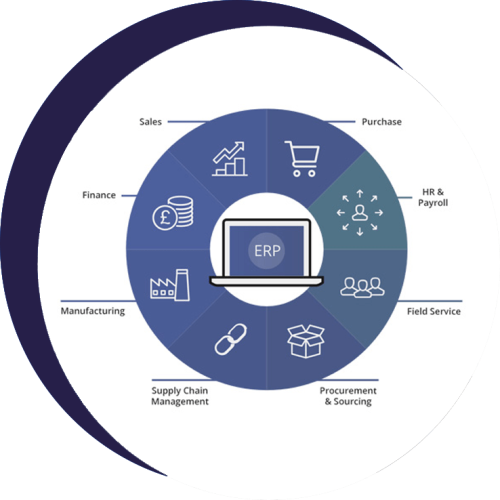IT/ ERP Systems Implementation
There are several crucial phases in the adoption of IT/ ERP Systems Implementation, and each one necessitates meticulous preparation, coordination, and cooperation amongst various stakeholders in the company.
Some of the services we offer include:
- Independently assess and confirm the client’s readiness to implement the ERP and document the business case and measures of success the organization anticipates from this investment.
- Guide and participate in the pre-implementation detailed discover workshops to be held between the client subject matter leads in the respective modules (HCM, order to cash, procure to pay, financials, materials management, fixed assets, warehouse management) and OEM’s Oracle and Microsoft, and prepare detailed business requirements and scope of work for the project.
- Create the project charter, the detailed workplan and resource requirements.
- Lead the vendor and system contracting
- Lead and drive implementation.
- Work collaboratively with all stakeholders, model the client’s values and transfer capability to the internal team.
- Monitor, identify and mitigate the risks associated with the project.
- Report progress, concerns, decisions required to the team/ management on a periodic basis.
- Deliver the project in scope, on time and within or preferably under budget. Fulfil the business case and realize the return expected on the investment made.

IT/ ERP Systems Implementation Selection:
Systems for enterprise resource planning, or ERPs, are essential for optimizing corporate operations, increasing productivity, and boosting overall performance within an organization. Furthermore, choosing the appropriate ERP system is a crucial choice that has a big impact on the performance of a company. Here are some factors and standards we utilize to help us choose an ERP system in order to steer this process:
Criteria for selecting an IT/ERP system:
- Business Requirements Analysis:
- We start by conducting a thorough analysis of your organization’s business processes and requirements. Identify key areas that need improvement and define the functionalities your ERP system must support.
- Scalability:
- We choose an ERP system that can grow with your business. Scalability is crucial to accommodate future expansions and changes in business needs without the need for a major overhaul.
- Customization and Flexibility:
- We look for ERP systems that offer customization options to tailor the software to match your specific business processes. A flexible system allows for easier adaptation to unique requirements.
- User-Friendly Interface:
- A user-friendly interface is essential for widespread user adoption. We ensure that the ERP system is intuitive, easy to navigate, and requires minimal training for users.
- Integration Capabilities:
- The ERP system should seamlessly integrate with existing applications and systems within your organization. Integration capabilities reduce data silos and enhance data accuracy.
- Compliance and Security:
- We Verify that the ERP system complies with industry regulations and security standards. Data protection and privacy are paramount, especially when dealing with sensitive business information.
- Vendor Reputation and Support:
- We highly consider the reputation and experience of the ERP vendor. Therefore we look for a vendor with a proven track record of successful implementations and reliable customer support services.
- Total Cost of Ownership (TCO):
- We then evaluate the total cost of ownership, including upfront costs, licensing fees, maintenance, and ongoing support, so that we factor in any hidden costs for you to get a comprehensive understanding of the financial commitment.
- Cloud vs. On-Premises:
- We decide together whether a cloud-based or on-premises ERP solution better suits your organization’s needs. Cloud solutions offer flexibility and accessibility, while on-premises solutions provide greater control over data.
Project Planning and Management in ERP Implementation:
Implementing enterprise resource planning (ERP) is crucial for businesses looking to combine different corporate operations and procedures into a single, cohesive system. Moreover, meticulous preparation, including thorough analysis and planning, is essential to pave the way for a successful ERP deployment. Additionally, effective project management techniques play a pivotal role in ensuring a smooth integration process. Furthermore, a strong risk management plan is necessary to identify potential challenges and mitigate them proactively during the ERP implementation phase. In conclusion, a well-coordinated approach, encompassing meticulous preparation, effective project management, and robust risk management, is indispensable for achieving success in ERP deployment.
1. Project Management Methodologies for ERP Implementation:
Several project management methodologies can be applied to ERP implementation, including:
- Waterfall Methodology: This traditional approach involves a linear and sequential progression through phases such as planning, design, implementation, testing, and maintenance.
- Agile Methodology: Agile emphasizes flexibility and adaptability. It involves iterative development cycles, allowing for adjustments based on ongoing feedback.
- Scrum: A subset of Agile, Scrum involves short development cycles called sprints. It promotes collaboration and frequent reassessment of project priorities.
- Critical Path Method (CPM): CPM is a network analysis technique that identifies the longest path of activities to determine the project’s minimum duration.
2. Risk Management in ERP Projects:
ERP implementation projects are susceptible to various risks, and effective risk management is crucial to mitigate potential issues. Key aspects of risk management that we undertake in ERP projects include:
- Risk Identification: We identify potential risks early in the project. This includes technical challenges, resistance from users, data migration issues, and unexpected delays.
- Risk Assessment: We then Assess the impact and probability of each identified risk. Prioritize risks based on their potential impact on project timelines, budget, and overall success.
- Mitigation Strategies: Develop mitigation strategies for high-priority risks. This may involve contingency plans, additional resources, or alternative approaches to address potential challenges.
- Continuous Monitoring: We implement a system for continuous risk monitoring throughout the project lifecycle. Regularly reassess the risk landscape and adjust strategies as needed.
- Communication: It’s very important to maintain open and transparent communication with stakeholders. Keep them informed about potential risks and the steps being taken to mitigate them.
- Contingency Planning: We develop contingency plans for critical aspects of the project. This ensures that the project can recover quickly from unexpected setbacks without compromising its overall success.
3. Key performance indicators (KPIs) for measuring ERP implementation success.
Key Performance Indicators (KPIs) are essential for evaluating the effectiveness of Enterprise Resource Planning (ERP) deployment, especially in cases where our company provides this service. Furthermore, the successful adoption of the ERP system holds paramount significance for both our clients and our internal operations. This effective adoption aligns with our objectives, including achieving financial transparency, enhancing productivity, and optimizing client operations. We can use the following important KPIs to gauge how well our ERP implementation services are working.
- Project Timeline Adherence:
- Percentage of project completion within the scheduled timeline.
- Budget Compliance:
- Variance between the actual implementation cost and the budgeted cost.
- User Training and Adoption:
- Percentage of users trained and actively using the ERP system.
- Data Accuracy and Integrity:
- Percentage reduction in data errors and discrepancies.
- Process Efficiency Improvement:
- Percentage increase in process efficiency and automation.
- Audit and Compliance Readiness:
- Number of audit findings related to ERP processes.
- Customer Satisfaction:
- Net Promoter Score (NPS) or customer satisfaction surveys.
- Return on Investment (ROI):
- Percentage increase in profitability or cost savings attributed to ERP.
- System Downtime:
- Total hours of system downtime during and post-implementation.
- Issue Resolution Time:
- Average time taken to resolve ERP-related issues.
Successful IT/ERP systems implementation is not just about technology; rather it involves aligning technology with business objectives, engaging stakeholders, and fostering a culture of adaptability and continuous improvement.
